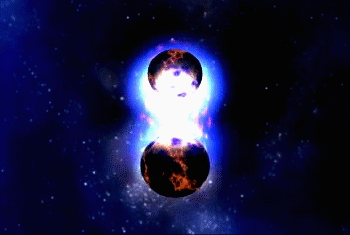Science News
Space Gold
July 23, 2013
by Alyssa Keimach

Space gold is even rarer than Earth gold, which makes the precious metal special—on our planet and in the Universe at large.
A team of astronomers at the Harvard-Smithsonian Center for Astrophysics (CfA) observed a special gamma-ray burst last month; these powerful phenomena appear to originate in cataclysmic events… and in this case it was likely the collision of two neutron stars.
Neutron stars are the dense remains of imploded stars: they are up to three times the mass of the Sun, condensed into the area of San Francisco.
Deep in their cores, regular stars create elements that are eventually spewed into space when the stars explode. Chris Impey, professor of astronomy at the University of Arizona, explains, “We know that stars make heavy elements, and late in their lives, they eject gas into the medium between stars so it can be part of subsequent stars and planets (and people).” Carbon, oxygen, nitrogen, and a host of other elements—even nickel and iron—all originate within different types of stars.
But it takes a collision between two neutron stars to create rare elements such as gold. The lead author of a recent paper, Edo Berger, describes the phenomenon by paraphrasing one of Carl Sagan’s famous quotes, “We are all star stuff, and our jewelry is colliding-star stuff.” And it makes sense—gold requires 79 protons, 79 electrons and 118 neutrons, a concoction only a dense neutron star would have the atomic supplies to produce.
When two particular neutron stars collided about 3.9 billion light years away from Earth, astronomers named the resulting gamma-ray burst GRB 130603B. Although the burst lasted only two-tenths of a second, a slowly fading infrared glow told the Harvard research team that the burst was particularly valuable.
“We estimate that the amount of gold produced and ejected during the merger of the two neutron stars may be as large as 10 moon masses—quite a lot of bling!” says Berger.
At today’s prices, the explosion would produce the equivalent of $10,000,000,000,000,000,000,000,000,000 (10 octillion dollars). But don’t get too excited: these types of explosions happen in our galaxy only once every 10,000 years, and you might find it difficult to go and collect the loot.
This is big money, but there are additional implications of the neutron star collision.
“We’ve been looking for a ‘smoking gun’ to link a short gamma-ray burst with a neutron star collision. The radioactive glow from GRB 130603B may be that smoking gun,” explains Wen-fai Fong, a graduate student and a co-author of the paper.
Now that we have better evidence linking gamma-ray bursts and neutron star collisions, perhaps we can gain insight into the mystery radio bursts found outside our galaxy!
Alyssa Keimach is an astronomy and astrophysics student at the University of Michigan and interns for the Morrison Planetarium.
Credit: NASA/Dana Berry